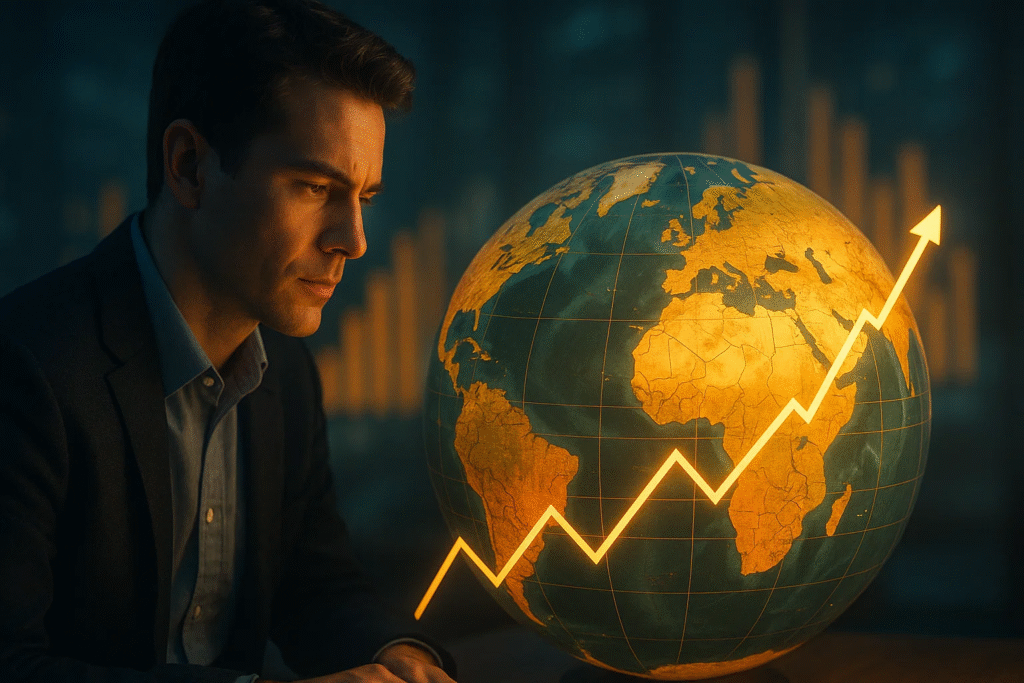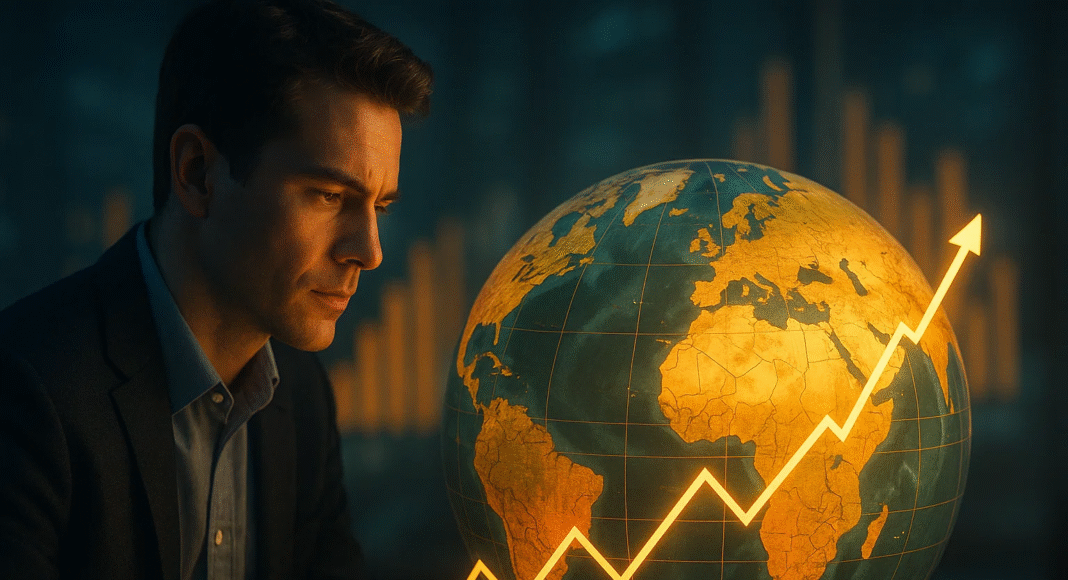Key Takeaways
• Global economic shifts reshape trade, technology, and labor markets, driving structural changes in global growth patterns.
• Businesses and nations that adapt to digital transformation, sustainability, and workforce evolution gain long-term competitiveness.
• Understanding these shifts enables organizations to anticipate risks, leverage opportunities, and build economic resilience.
The world economy is constantly evolving, shaped by a complex interplay of factors that influence trade, production, investment, and labor markets on a global scale. In recent decades, the pace of transformation has accelerated, giving rise to what economists and policymakers term as “global economic shifts.” These shifts represent deep, structural, and long-term changes in how economies operate, interact, and compete in a highly interconnected world. Unlike temporary economic cycles of growth and contraction, global economic shifts reflect the reconfiguration of global power, technological advancements, demographic transitions, and changing geopolitical realities that collectively redefine the global economic landscape.

Understanding these shifts is critical for governments, corporations, and individuals seeking to navigate the uncertainties of a rapidly changing global environment. As digital technologies, automation, and artificial intelligence reshape industries, the traditional centers of economic influence are being challenged by emerging markets that are gaining momentum in innovation, production, and consumption. Meanwhile, demographic changes—such as aging populations in developed nations and youth booms in emerging economies—are creating new patterns of labor supply, investment flows, and market demand. Added to these are geopolitical tensions, trade realignments, and the growing emphasis on sustainability, all of which contribute to a multifaceted transformation in the world economy.
The post-pandemic era has further intensified these shifts. The COVID-19 crisis disrupted global supply chains, altered consumer behavior, and forced companies to rethink their dependence on single-source manufacturing hubs. What followed was an accelerated push toward diversification, regionalization, and digital transformation. Similarly, the rise of green energy and sustainability-focused investments is changing how countries and corporations allocate resources and pursue economic growth. These developments have not only altered competitive dynamics but also exposed the interconnected vulnerabilities of global markets, prompting the need for more resilient and adaptive economic systems.
To grasp how global economic shifts work, one must look beyond short-term financial trends and examine the underlying mechanisms that drive transformation. These include the flow of capital and technology across borders, changes in global trade agreements, shifts in consumer preferences, and evolving government policies that influence international markets. Each shift carries ripple effects that impact employment patterns, industry competitiveness, and national economies differently, depending on how well they adapt to new realities. The result is a continuous rebalancing act where nations and businesses must anticipate change, build flexibility, and leverage innovation to maintain relevance.
Moreover, global economic shifts are not uniform in their impact. Some countries benefit from industrial growth and increased foreign investment, while others face deindustrialization, capital flight, or widening inequality. The outcomes depend heavily on a nation’s economic structure, governance, technological readiness, and integration into global value chains. For businesses, especially those in sectors such as manufacturing, finance, technology, and human resources, understanding these shifts is no longer optional—it is essential for strategic planning, workforce development, and long-term competitiveness.
In essence, global economic shifts are the cumulative result of evolving technologies, shifting demographics, environmental imperatives, and political realignments that collectively redefine how value is created and distributed across the world. They determine which nations will lead in innovation, which industries will thrive, and which will decline in the coming decades. By studying these shifts in depth—how they emerge, propagate, and reshape global interdependence—policymakers and business leaders can make informed decisions to mitigate risks, harness new opportunities, and build sustainable growth strategies.
This comprehensive exploration of global economic shifts delves into their causes, mechanisms, and implications for economies, industries, and the workforce. It also examines the pivotal role of technology, sustainability, and human capital in driving this transformation. Ultimately, understanding how global economic shifts work provides invaluable insight into the future trajectory of the world economy—and offers a roadmap for navigating the profound changes shaping the 21st-century global order.
Before we venture further into this article, we would like to share who we are and what we do.
About 9cv9
9cv9 is a business tech startup based in Singapore and Asia, with a strong presence all over the world.
With over nine years of startup and business experience, and being highly involved in connecting with thousands of companies and startups, the 9cv9 team has listed some important learning points in this overview of What are Global Economic Shifts and How Do They Work.
If your company needs recruitment and headhunting services to hire top-quality employees, you can use 9cv9 headhunting and recruitment services to hire top talents and candidates. Find out more here, or send over an email to [email protected].
Or just post 1 free job posting here at 9cv9 Hiring Portal in under 10 minutes.
What are Global Economic Shifts and How Do They Work
- What do we mean by “Global Economic Shifts”?
- Key Drivers of Global Economic Shifts
- How These Shifts Work – Mechanisms & Dynamics
- Major Examples of Global Economic Shifts (Past & Present)
- Impacts of Global Economic Shifts on Business, Labour and HR Tech (relevant to your role)
- What organisations can do to respond & adapt
- Challenges and Risks Associated with Global Economic Shifts
- Future Outlook: What to Watch For
1. What do we mean by “Global Economic Shifts”?
Global economic shifts refer to fundamental and long-term transformations that reshape how the world economy functions, distributes wealth, and creates value. These shifts go beyond temporary fluctuations such as recessions or business cycles—they reflect changes in structural, technological, demographic, and geopolitical dimensions. Understanding these shifts helps explain why economic power is moving from one region to another, how industries evolve, and what forces determine competitiveness in a rapidly changing global environment.
Definition and Concept
Global economic shifts describe the process by which economic influence, production capacity, innovation, and consumption patterns transition across countries and sectors. They signify enduring reconfigurations of global trade, financial systems, and labor markets that redefine international relationships. Unlike cyclical changes that follow predictable ups and downs, these shifts often unfold over decades and create lasting impacts on global prosperity, governance, and stability.
Key Characteristics of Global Economic Shifts
- Structural and Long-Term: They emerge gradually but lead to permanent transformations in economic systems.
- Multi-Dimensional: Involve interactions between technology, demographics, trade, and geopolitics.
- Global Interdependence: Shifts in one region affect economies and industries worldwide.
- Uneven Impact: Some nations or sectors benefit, while others face decline or stagnation.
- Driven by Innovation and Adaptation: Technological advancements often accelerate the pace of transformation.
Types of Global Economic Shifts
There are several forms of global economic shifts, each characterized by different drivers and outcomes.
Table 1: Major Types of Global Economic Shifts and Their Core Features
| Type of Shift | Description | Key Examples | Impact |
|---|---|---|---|
| Structural Shift | Transition of economies from agriculture to industry and services | Industrial Revolution; rise of knowledge economy | Creates new employment structures and urbanization |
| Technological Shift | Transformation driven by innovation and digitalization | AI, automation, Internet of Things | Increases productivity but displaces traditional jobs |
| Geographic Shift | Redistribution of global economic power among regions | Rise of Asia-Pacific; BRICS expansion | Alters trade flows and investment destinations |
| Demographic Shift | Changes in population structure and labor dynamics | Aging in Japan and Europe; youth boom in Africa | Influences labor availability and consumer markets |
| Environmental Shift | Movement towards sustainability and green growth | Renewable energy revolution; carbon-neutral goals | Drives investment in clean technology and green finance |
Distinguishing Shifts from Economic Cycles
While economic cycles involve short-term patterns of expansion and contraction, global economic shifts indicate deeper realignments that redefine the long-term trajectory of the world economy.
Matrix 1: Comparison Between Economic Cycles and Global Economic Shifts
| Criteria | Economic Cycle | Global Economic Shift |
|---|---|---|
| Duration | 3–10 years | 20–50 years or more |
| Nature | Temporary fluctuations | Structural transformation |
| Key Drivers | Monetary and fiscal policies, consumer demand | Technology, demographics, geopolitics |
| Impact | Short-term on GDP and employment | Long-term on productivity, trade, and power balance |
| Adaptation Need | Minimal or cyclical adjustment | Fundamental policy, innovation, and strategy changes |
Historical Examples of Global Economic Shifts
- The Industrial Revolution: Transition from agrarian economies to industrial production in 18th–19th century Europe marked the first major global shift, enabling mechanization and mass manufacturing.
- Post-World War II Economic Order: The establishment of institutions like the IMF, World Bank, and GATT shaped the modern global financial system and promoted globalization.
- Rise of Emerging Markets: Since the late 20th century, countries such as China, India, and Brazil have become major economic powers, driving production and consumption growth.
- Digital Transformation: The current era of AI, cloud computing, and automation represents a technological shift that is redefining how businesses create and deliver value worldwide.
- Sustainability Transition: The global movement toward carbon neutrality and renewable energy investments represents an environmental and resource-based shift with long-term implications for industry and trade.
Mechanisms of Global Economic Shifts
Global economic shifts operate through several interconnected mechanisms:
- Technological Innovation: Automation and digitalization increase productivity and alter global labor dynamics.
- Trade Reconfiguration: Supply chains are restructured through nearshoring, friend-shoring, and diversification.
- Capital Flow Adjustments: Investments shift toward emerging markets, renewable energy, and technology sectors.
- Policy Realignment: Governments adapt fiscal and trade policies to accommodate new realities.
- Consumer Behavior: Changing income levels and preferences drive demand for new types of goods and services.
Illustrative Chart: Stages of Global Economic Shift Evolution
Stage 1: Trigger Phase – Technological or geopolitical disruption initiates change.
Stage 2: Adjustment Phase – Industries and governments modify production and trade strategies.
Stage 3: Acceleration Phase – Rapid adoption of new models, such as digital platforms or green industries.
Stage 4: Consolidation Phase – New global structures and economic hierarchies become established.
Geographical Perspective on Economic Power Rebalancing
The global economic center of gravity has been steadily shifting from traditional Western economies to Asia and other emerging regions. According to global output data, Asia’s contribution to world GDP rose from less than 20% in 1990 to over 45% by 2025.
Table 2: Share of Global GDP by Region (1990–2025 Projection)
| Region | 1990 | 2000 | 2010 | 2025 (Projected) |
|---|---|---|---|---|
| North America | 28% | 27% | 24% | 21% |
| Europe | 32% | 30% | 27% | 22% |
| Asia-Pacific | 18% | 25% | 37% | 45% |
| Latin America | 10% | 9% | 8% | 7% |
| Africa | 4% | 5% | 6% | 7% |
The rapid growth of Asian economies such as China, India, Indonesia, and Vietnam illustrates how global production and consumption are rebalancing eastward. This shift impacts not only trade routes and supply chains but also the competitive strategies of multinational corporations and global investors.
Implications of Understanding Global Economic Shifts
- Enables policymakers to design adaptive economic strategies that ensure competitiveness.
- Helps corporations identify new markets and optimize supply-chain structures.
- Assists investors in reallocating portfolios to emerging sectors and regions.
- Guides workforce planning and HR strategies to meet evolving skill demands.
In conclusion, global economic shifts represent the underlying movements that redefine how the world creates, distributes, and sustains economic growth. They are long-term, interconnected transformations that extend beyond national borders, influencing policies, businesses, and societies alike. Recognizing and understanding these shifts is essential for predicting future opportunities, mitigating risks, and navigating the global economic landscape effectively.
2. Key Drivers of Global Economic Shifts
Global economic shifts are not random occurrences; they are driven by identifiable and measurable forces that alter the dynamics of international production, trade, innovation, and labor markets. These drivers operate both independently and collectively, shaping the trajectory of global economic transformation. Understanding them is essential for businesses, policymakers, and investors seeking to anticipate long-term changes in economic structures and global competitiveness.
Technological Innovation and Digital Transformation
Technological progress stands at the heart of modern global economic shifts. The rise of automation, artificial intelligence, and digitalization has transformed production models, communication systems, and service delivery.
- Automation and AI Integration: Industries are increasingly adopting automation and AI tools to optimize efficiency, reduce costs, and enhance precision. This technological evolution has led to job displacement in traditional manufacturing while creating new roles in data science, machine learning, and digital engineering.
- Digitalization of Commerce: The expansion of e-commerce, digital payment systems, and online platforms has connected global consumers and suppliers. Examples include the rapid growth of Alibaba and Amazon, which demonstrate how digital platforms reshape global trade networks.
- Innovation Clusters: Technology hubs such as Silicon Valley, Shenzhen, and Bangalore illustrate how innovation-driven ecosystems stimulate economic growth and attract global capital.
- Data-Driven Decision-Making: The increasing importance of big data analytics and cloud computing has changed how businesses make strategic decisions and allocate resources.
Table 1: Impact of Technological Innovation on Global Economic Shifts
| Technological Area | Economic Effect | Example |
|---|---|---|
| Artificial Intelligence | Enhances productivity; replaces repetitive tasks | AI-based automation in logistics and manufacturing |
| Robotics | Reduces labor dependency in industrial production | Automotive and electronics industries in Japan and South Korea |
| Fintech | Expands financial inclusion and global digital payments | Rise of mobile banking in Africa (M-Pesa) |
| Cloud Computing | Enables scalable global business operations | Global SaaS platforms such as Salesforce and Microsoft Azure |
Supply Chain Restructuring and Global Production Rebalancing
Supply chains have become one of the most significant areas of transformation, especially after the pandemic and rising geopolitical tensions.
- Nearshoring and Friend-Shoring: Companies are moving production closer to home markets or politically allied regions to reduce dependency on single countries. For example, the “China +1” strategy has led firms to expand production into Vietnam, Thailand, and India.
- Resilience over Efficiency: Businesses now prioritize supply chain resilience and risk diversification over pure cost-efficiency.
- Technological Integration: The use of blockchain and IoT in supply chain management enhances transparency, efficiency, and traceability.
- Regionalization of Trade: The growth of trade blocs such as the Regional Comprehensive Economic Partnership (RCEP) and the African Continental Free Trade Area (AfCFTA) represents a shift toward regional economic cooperation.
Matrix 1: Global Supply Chain Realignment Patterns
| Strategy | Description | Key Regions Affected | Outcome |
|---|---|---|---|
| Offshoring | Moving production to low-cost countries | Southeast Asia, Latin America | Cost reduction but high dependency risk |
| Nearshoring | Shifting production closer to primary markets | North America, Europe | Shorter lead times, improved resilience |
| Friend-Shoring | Relocating to politically aligned nations | India, Vietnam, Mexico | Reduces geopolitical risk |
| Reshoring | Bringing production back to home country | United States, Germany | National security and job creation focus |
Geopolitical and Trade Dynamics
Geopolitical shifts and evolving trade relationships have profound implications for global economics.
- Fragmentation of Globalization: Tensions between major powers, such as the United States and China, have accelerated the fragmentation of global supply networks. Trade policies and sanctions are increasingly used as tools of strategic competition.
- Emerging Economic Alliances: Nations are forming new partnerships based on mutual economic interests, such as BRICS expansion and ASEAN economic integration.
- Protectionism vs. Open Trade: Tariffs, trade barriers, and local-content rules are reshaping international commerce.
- Global Energy Geopolitics: The control over energy resources, particularly the transition from fossil fuels to renewables, influences trade balances and strategic priorities.
Chart 1: Global Trade Realignment and Emerging Regional Power Blocs
- North America: Increasing integration through USMCA and investments in nearshoring.
- Europe: Strengthening of intra-European supply chains and green economy initiatives.
- Asia-Pacific: Rapid expansion under RCEP and dominance in electronics, manufacturing, and energy transition industries.
- Africa: Rising potential under AfCFTA as a unified trading bloc with growing consumer markets.
Demographic and Labor Market Dynamics
Demographic trends significantly determine global labor supply, consumer demand, and productivity growth.
- Aging Populations: Developed economies such as Japan, Germany, and Italy are facing declining workforces and increasing dependency ratios.
- Youthful Economies: Emerging nations, including Nigeria, India, and Indonesia, have abundant young labor forces that attract investment and manufacturing relocation.
- Migration and Talent Mobility: The movement of skilled labor across borders is reshaping workforce composition and creating new global talent markets.
- Gender and Workforce Inclusion: Greater emphasis on gender equality and inclusive labor participation contributes to productivity growth and social stability.
Table 2: Global Demographic Trends and Their Economic Implications
| Region | Dominant Trend | Economic Implication | Example |
|---|---|---|---|
| Europe | Aging population | Shrinking labor force; automation investment | Germany’s investment in robotics |
| North America | Moderate population growth | Balanced labor market with skilled immigration | Canada’s talent immigration strategy |
| Asia | Young population in emerging markets | Expanding labor pool and consumption power | India’s youth-driven digital economy |
| Africa | Rapid population growth | Potential demographic dividend; infrastructure strain | Nigeria’s growing tech hubs |
| Latin America | Urbanization growth | Expansion of service industries | Brazil’s fintech expansion |
Environmental Sustainability and Green Transitions
Sustainability has become a defining factor of modern economic transformation. The global transition toward renewable energy and eco-friendly production practices drives structural shifts in industries and investment flows.
- Renewable Energy Expansion: Nations are investing heavily in solar, wind, and hydroelectric projects to reduce reliance on fossil fuels.
- Carbon Neutrality Goals: Governments and corporations commit to achieving net-zero emissions, creating new demand for green technologies.
- Circular Economy Models: Businesses increasingly adopt recycling, waste reduction, and sustainable sourcing strategies.
- Green Finance and ESG Investment: Investors are reallocating capital toward environmentally responsible projects, accelerating the global green transformation.
Table 3: Major Global Green Transition Drivers
| Sector | Green Innovation | Leading Economies | Outcome |
|---|---|---|---|
| Energy | Solar, wind, hydrogen energy | China, Germany, United States | Reduction in carbon emissions and energy diversification |
| Transport | Electric vehicles, battery innovation | Norway, China, United States | Growth in EV manufacturing and supply chains |
| Finance | ESG and green bonds | EU, Singapore, Japan | Increased investment in sustainable projects |
| Manufacturing | Sustainable materials and production | South Korea, Sweden, Netherlands | Lower carbon footprint and improved brand value |
Financial and Capital Market Dynamics
Global financial markets play a pivotal role in amplifying economic shifts. The movement of capital across borders influences the development of emerging markets and the restructuring of industries.
- Rise of Emerging Market Investments: Institutional investors are diversifying portfolios into Asia, Africa, and Latin America to capture higher growth potential.
- Digital Finance Transformation: Cryptocurrencies, decentralized finance (DeFi), and blockchain are redefining global financial intermediation.
- Monetary Policy Divergence: Differences in interest rate strategies among major economies affect capital flows and currency valuations.
- Inflation and Debt Realignment: Global inflationary pressures and rising public debt levels create new fiscal challenges for developing and advanced economies alike.
Table 4: Global Investment and Financial Trends
| Trend | Description | Example |
|---|---|---|
| Shift to Emerging Markets | Investors seek high-growth economies | Increased FDI in Vietnam and India |
| DeFi Expansion | Blockchain-based decentralized finance | Global adoption of smart contract platforms |
| ESG Integration | Financial markets align with sustainability goals | EU Green Deal investment initiatives |
| Inflation Response | Monetary tightening in advanced economies | U.S. Federal Reserve rate hikes |
Conclusion
The drivers of global economic shifts—technological innovation, supply chain transformation, geopolitical realignment, demographic transitions, sustainability efforts, and financial evolution—operate as interlinked forces shaping the future of the global economy. These drivers collectively determine how nations, industries, and individuals will adapt to changing economic realities. By analyzing these forces in depth, stakeholders can identify emerging opportunities, mitigate strategic risks, and position themselves advantageously within the evolving global landscape.
3. How These Shifts Work – Mechanisms & Dynamics
Understanding how global economic shifts operate requires examining the interconnected mechanisms that drive transformations across international markets, industries, and financial systems. These shifts are not isolated phenomena but the result of complex interactions between macroeconomic forces, technological innovations, policy decisions, and behavioral trends among consumers and corporations.
Global economic shifts work through several key dynamics—transmission mechanisms, feedback loops, and structural adjustments—that collectively shape global growth, trade balances, and investment flows.
1. Transmission Mechanisms of Global Economic Shifts
Transmission mechanisms describe how changes in one part of the global economy spread to others. These mechanisms can occur through trade, finance, investment, and labor markets.
- Trade Channels
- A shift in consumer demand or production costs in one country affects export and import patterns globally. For instance, China’s rapid industrialization in the early 2000s reshaped global supply chains, increasing demand for raw materials from Africa and South America.
- Tariffs, sanctions, and free-trade agreements can amplify or restrict these flows, altering the global balance of trade.
- Financial Channels
- Monetary policies in major economies influence global interest rates, currency exchange rates, and capital flows.
- For example, when the US Federal Reserve raises interest rates, capital often flows from emerging markets back into US assets, leading to currency depreciation and tighter liquidity conditions in developing economies.
- Investment Channels
- Foreign direct investment (FDI) acts as a conduit for global capital redistribution. Companies invest in markets with competitive advantages such as lower labor costs or tax incentives, which can alter local economic landscapes.
- The rise of multinational corporations has intensified this dynamic, enabling production and innovation to shift fluidly across borders.
- Labor and Migration Channels
- Global labor mobility allows economies to adjust to demographic and wage differentials.
- For example, labor migration from Eastern to Western Europe after the EU expansion in 2004 helped balance workforce shortages and wage disparities.
Table 1: Key Transmission Channels of Global Economic Shifts
| Channel Type | Mechanism of Impact | Example Case |
|---|---|---|
| Trade | Shifts in demand/supply | China’s export-led growth |
| Financial | Monetary policy and capital flows | US interest rate hikes affecting emerging markets |
| Investment | Global FDI relocation | Manufacturing movement to Southeast Asia |
| Labor | Migration and wage equalization | EU workforce mobility |
2. Feedback Loops and Economic Interdependence
Feedback loops occur when initial economic changes create secondary effects that reinforce or counteract the original shift.
- Positive Feedback Loops
- Economic growth in one region can stimulate demand for imports from others, creating a cycle of global expansion.
- Example: The digital economy’s rise increased global demand for semiconductor production, leading to industrial growth in Taiwan and South Korea.
- Negative Feedback Loops
- Inflation, trade imbalances, or policy tightening can create contractionary effects.
- Example: The 2008 financial crisis began in the US housing market but rapidly spread through global banking systems, leading to synchronized recessions worldwide.
3. Structural Adjustments and Policy Responses
As economies adapt to global shifts, governments and institutions implement structural reforms and policy responses to stabilize growth and maintain competitiveness.
- Monetary and Fiscal Adjustments
- Central banks may alter interest rates, conduct quantitative easing, or manage currency interventions to stabilize domestic markets.
- Example: Japan’s prolonged deflationary environment led to aggressive monetary easing under Abenomics.
- Trade and Industrial Policies
- Nations may realign their trade partnerships or incentivize new industries to adapt to changing demand patterns.
- Example: India’s “Make in India” initiative aimed to boost domestic manufacturing in response to global supply chain reconfigurations.
- Technological and Workforce Reskilling Initiatives
- Automation and AI integration force economies to shift from labor-intensive to knowledge-based industries.
- Governments respond by investing in digital literacy and innovation ecosystems.
Table 2: Examples of Structural Adjustments in Response to Global Shifts
| Adjustment Type | Policy Example | Outcome |
|---|---|---|
| Monetary Policy | ECB quantitative easing | Stimulated Eurozone liquidity |
| Industrial Policy | Make in India | Enhanced local manufacturing |
| Technological Reform | Digital literacy programs | Strengthened workforce adaptability |
4. The Role of Global Institutions and Governance
Institutions like the International Monetary Fund (IMF), World Trade Organization (WTO), and World Bank play crucial roles in moderating global economic shifts.
- They provide financial aid, policy guidance, and structural adjustment programs during crises.
- They promote international cooperation and reduce the likelihood of protectionist retaliation.
- For instance, during the COVID-19 pandemic, global institutions coordinated recovery funds and stimulus frameworks to mitigate economic fallout.
5. Dynamic Interactions Between Developed and Emerging Economies
The interplay between advanced and developing economies lies at the core of modern economic transitions.
- Capital Flow Dynamics
- Developed countries often serve as capital exporters, while emerging economies absorb investments that fuel industrial growth.
- However, sudden shifts in investor confidence can reverse these flows, causing volatility.
- Technological Diffusion
- Innovations developed in advanced economies eventually spread to emerging markets, boosting productivity but also increasing competition.
Chart 1: Flow of Economic Influence Between Developed and Emerging Markets
Developed Economies → Capital, Technology, Demand
Emerging Economies → Labor, Resources, Manufacturing
6. Long-Term Evolutionary Dynamics
Global economic shifts evolve gradually through innovation cycles, demographic transitions, and geopolitical realignments.
- Innovation Cycles
- New technologies, such as artificial intelligence and renewable energy, redefine productivity and reshape global value chains.
- Demographic Transitions
- Aging populations in developed economies contrast with youthful labor forces in Africa and Southeast Asia, leading to shifts in consumption and investment.
- Geopolitical Realignments
- Trade blocs, regional alliances, and sanctions influence long-term trade patterns and economic power distributions.
Conclusion
Global economic shifts work through interconnected mechanisms that transmit, reinforce, and transform changes across nations and industries. Understanding these dynamics is crucial for policymakers, businesses, and investors aiming to anticipate and adapt to the evolving global economic environment.
4. Major Examples of Global Economic Shifts (Past & Present)
Throughout history, major global economic shifts have redefined the structure of international trade, finance, labor distribution, and geopolitical power. These transformations are driven by wars, technological revolutions, demographic transitions, and policy changes that collectively reshape the global economic order. Understanding both past and contemporary examples allows for a clearer grasp of how such shifts emerge, evolve, and influence the global marketplace.
1. The Industrial Revolution – The Foundation of Modern Economic Systems
The Industrial Revolution, which began in Britain during the late 18th century, marked the first major global economic shift from agrarian economies to industrialized production systems.
- Technological Transformation
- The invention of the steam engine, spinning jenny, and mechanized looms revolutionized production efficiency.
- It led to rapid urbanization and the creation of industrial cities such as Manchester and Birmingham.
- Global Trade Expansion
- Industrialized nations began exporting manufactured goods, while colonies supplied raw materials such as cotton, coal, and iron.
- This created the first globalized trade network underpinned by industrial output.
- Labor Market Evolution
- The rise of factory-based employment replaced agricultural work, leading to new labor movements and wage systems.
Table 1: Economic Transformation during the Industrial Revolution
| Indicator | Pre-Industrial Era | Post-Industrial Revolution |
|---|---|---|
| Dominant Sector | Agriculture | Manufacturing |
| Labor Type | Manual and rural | Mechanized and urban |
| Trade Structure | Local and regional | Global and industrial |
2. The Great Depression (1929–1939) – The Shift in Global Financial Regulation
The Great Depression remains one of the most significant global economic disruptions of the 20th century, reshaping economic policies and financial systems worldwide.
- Origins and Impact
- The 1929 US stock market crash triggered a domino effect across global economies, leading to mass unemployment, deflation, and trade collapse.
- International trade contracted by nearly 65% between 1929 and 1933 due to protectionist policies such as the Smoot-Hawley Tariff Act.
- Global Policy Responses
- The crisis led to the establishment of Keynesian economic principles, emphasizing government intervention to stimulate demand.
- Post-war institutions like the IMF and World Bank were created to stabilize the global financial system.
3. Post-World War II Reconstruction – The Bretton Woods System
The post-World War II era marked another monumental shift toward structured international economic cooperation.
- Bretton Woods Agreement (1944)
- Established fixed exchange rates tied to the US dollar, promoting stability in international trade.
- Created the IMF and World Bank to regulate and assist global economic development.
- Rise of the US Dollar as a Global Reserve Currency
- The dominance of the US in global production and trade positioned the dollar as the foundation of post-war finance.
- Global Economic Expansion
- The “Golden Age of Capitalism” (1950s–1970s) witnessed strong GDP growth, technological innovation, and rising living standards across industrialized nations.
Chart 1: Global GDP Growth Trends (1950–1970)
| Year Range | Average Global GDP Growth | Key Contributing Factors |
|---|---|---|
| 1950–1960 | 4.5% | Post-war reconstruction, industrial expansion |
| 1960–1970 | 5.1% | Technological modernization, trade liberalization |
4. The Rise of Asian Economies – The East Asian Miracle (1970s–1990s)
The latter half of the 20th century saw a dramatic shift of economic power toward East Asia, transforming global production and trade dynamics.
- Emergence of the “Four Asian Tigers”
- South Korea, Taiwan, Hong Kong, and Singapore achieved rapid industrialization through export-led growth.
- Government-led economic planning, investment in education, and foreign technology adoption were central to their success.
- Japan’s Economic Expansion
- Japan became the world’s second-largest economy by the 1980s, driven by innovation in manufacturing and electronics.
- Shift in Global Manufacturing
- Asia’s rise repositioned the region as the global manufacturing hub, reducing Western dominance in production.
Table 2: Comparative Growth of East Asian Economies (1960–1990)
| Country | Average GDP Growth | Key Industry | Global Impact |
|---|---|---|---|
| Japan | 7.3% | Automotive, Electronics | Global industrial innovation |
| South Korea | 8.4% | Shipbuilding, Steel | Export-led model replication |
| Taiwan | 9.2% | Semiconductors | Global tech manufacturing hub |
5. The Collapse of the Soviet Union (1991) – Transition from Command to Market Economies
The dissolution of the USSR in 1991 reshaped geopolitical and economic landscapes across Eurasia.
- Economic Transition
- Former Soviet states shifted from centrally planned economies to market-oriented systems, introducing privatization and liberalization.
- Global Repercussions
- Opened new markets for Western investment and trade.
- Increased global supply of natural resources such as oil and gas from Russia and Central Asia.
- Institutional Influence
- The IMF and World Bank played key roles in guiding post-Soviet economic reforms.
6. The Digital Revolution (1990s–Present)
The rise of digital technologies, the internet, and artificial intelligence marks one of the most transformative economic shifts of the 21st century.
- Emergence of the Knowledge Economy
- Transition from industrial-based economies to data-driven, service-oriented systems.
- Companies like Apple, Amazon, and Google redefined global business operations and market competition.
- Global Connectivity
- The internet facilitated cross-border e-commerce, remote work, and the rise of the gig economy.
- Automation and Artificial Intelligence
- Advanced robotics and AI systems have restructured labor markets and productivity paradigms.
Table 3: Economic Transformation Driven by Digital Technologies
| Era | Dominant Sector | Example Companies | Key Global Impact |
|---|---|---|---|
| 1990–2000 | IT Services | Microsoft, IBM | Technological diffusion |
| 2000–2010 | E-commerce | Amazon, Alibaba | Global retail disruption |
| 2010–2025 | AI & Automation | Google, Tesla | Workforce transformation |
7. The Global Financial Crisis (2008–2009) – Redefining Financial Governance
The 2008 financial collapse reshaped the structure of global finance, leading to regulatory overhauls and shifts in investor confidence.
- Origins and Consequences
- Triggered by subprime mortgage defaults in the US, it led to global credit freezes, bank failures, and recessions across multiple continents.
- Policy Responses
- Governments introduced bailouts, stimulus packages, and stricter banking regulations such as Basel III.
- Long-Term Impact
- Accelerated the rise of fintech and digital banking to improve transparency and risk management.
Chart 2: Post-2008 Financial Recovery Trajectory
| Region | GDP Decline (2009) | Recovery Period | Key Policy Response |
|---|---|---|---|
| USA | -2.6% | 2010–2012 | Quantitative easing |
| EU | -4.4% | 2011–2014 | ECB liquidity programs |
| China | +9.2% | Continued Growth | Fiscal stimulus investments |
8. The COVID-19 Pandemic (2020–2022) – Reshaping Global Supply Chains and Labor Systems
The pandemic caused one of the most abrupt global economic disruptions in modern history.
- Global Lockdowns and Economic Paralysis
- Factory closures and border restrictions disrupted supply chains in critical sectors such as electronics, pharmaceuticals, and automotive.
- Digital Acceleration
- Companies adopted remote work technologies and e-commerce at unprecedented rates.
- Policy Interventions
- Trillions in stimulus measures were introduced globally to stabilize employment and business continuity.
Table 4: Economic Impact of COVID-19 Across Major Regions
| Region | GDP Contraction (2020) | Key Sector Impacted | Major Policy Response |
|---|---|---|---|
| North America | -3.7% | Travel, Manufacturing | Stimulus packages |
| Europe | -6.2% | Tourism, Retail | Fiscal recovery plans |
| Asia | -1.5% | Exports, Supply Chain | Targeted economic support |
9. The Green Energy Transition – The Next Great Economic Shift
As nations pursue carbon neutrality, the transition to renewable energy represents a profound structural change in the global economy.
- Decarbonization Efforts
- Countries are investing in solar, wind, and hydrogen energy to replace fossil fuels.
- The shift is generating new industries and employment sectors while challenging traditional oil economies.
- Investment Flows and Innovation
- Massive investments are being channeled into electric vehicles, clean technology, and energy storage solutions.
- Geopolitical Reorientation
- The dominance of energy-exporting nations is being redefined as renewable technologies decentralize power production.
Chart 3: Projected Growth in Global Renewable Energy Investment (2020–2035)
| Year | Total Global Investment (USD Trillion) | Growth Rate |
|---|---|---|
| 2020 | 0.8 | — |
| 2025 | 1.5 | +87% |
| 2030 | 2.6 | +173% |
| 2035 | 3.9 | +270% |
Conclusion
From the Industrial Revolution to the digital and green transformations of the 21st century, global economic shifts have continuously redefined how nations trade, innovate, and grow. Each shift has introduced new winners and challenges, highlighting the dynamic and interconnected nature of the world economy. By studying these transitions, policymakers and investors can anticipate emerging trends and position themselves strategically in the evolving global economic landscape.
5. Impacts of Global Economic Shifts on Business, Labour and HR Tech (relevant to your role)
Global economic shifts profoundly influence how businesses operate, how labor markets evolve, and how technology—especially HR tech—adapts to changing dynamics. These transformations shape strategies in workforce management, automation, talent acquisition, and organizational resilience. As the world economy undergoes structural realignments, businesses and HR leaders must understand the cascading effects across industries, demographics, and technological ecosystems.
1. Impact on Business Operations and Strategy
Global economic shifts compel organizations to rethink business strategies, cost structures, and global market positioning. Companies are increasingly required to balance agility, risk management, and innovation to sustain competitiveness.
- Market Diversification and Expansion
- Businesses respond to economic fluctuations by diversifying into emerging markets. For instance, multinational corporations have expanded operations into Southeast Asia due to lower labor costs and rising consumer demand.
- Economic shifts encourage companies to reduce dependency on single regions, mitigating risks from trade wars or supply chain disruptions.
- Supply Chain Reconfiguration
- Global supply chains are among the first systems affected by economic shifts.
- The COVID-19 pandemic, for example, exposed vulnerabilities in over-reliance on single-source suppliers from China, prompting a global move toward nearshoring and regionalization strategies.
- Technological tools like predictive analytics and AI-based logistics optimization are increasingly adopted to enhance supply chain resilience.
- Digital Transformation and Automation
- Economic volatility accelerates digitalization.
- Businesses leverage automation, cloud computing, and AI to reduce costs and increase operational efficiency.
- Example: During the 2008 financial crisis, many organizations adopted digital accounting systems and automated reporting tools to manage compliance more efficiently.
Table 1: Business Strategy Adjustments in Response to Global Economic Shifts
| Area of Adjustment | Strategic Response | Example |
|---|---|---|
| Market Expansion | Diversify into emerging markets | Firms expanding in ASEAN post-China slowdown |
| Supply Chain | Regionalization & digital optimization | Adoption of AI-driven logistics platforms |
| Technology | Automation & digitization | AI and ERP adoption in finance and manufacturing |
2. Impact on Labour Markets and Workforce Dynamics
The structure and dynamics of labor markets shift significantly in response to global economic transitions. Changes in employment demand, skill requirements, and workforce distribution are direct consequences of these macroeconomic adjustments.
- Job Creation and Displacement
- Technological revolutions often create new jobs while rendering traditional ones obsolete.
- Example: The rise of automation has displaced repetitive manufacturing roles but generated demand for data scientists, AI engineers, and digital strategists.
- A study by the World Economic Forum projects that by 2030, over 85 million jobs may be displaced, but 97 million new digital roles will emerge.
- Gig Economy and Flexible Employment
- Economic uncertainty encourages businesses to embrace flexible labor models.
- The gig economy has expanded rapidly, with platforms like Upwork and Fiverr enabling short-term, project-based work.
- This shift offers cost efficiency for employers and flexibility for workers, but it also introduces challenges in labor protection and benefits management.
- Global Mobility and Remote Work
- Economic shifts, particularly those triggered by technological and geopolitical developments, have redefined work mobility.
- Remote work adoption during the COVID-19 pandemic became a permanent trend for many industries, reducing operational costs and widening global talent access.
- Organizations now leverage HR tech tools such as Deel and Remote.com to manage international workforce compliance and payroll seamlessly.
Table 2: Labor Market Evolution under Global Economic Shifts
| Trend | Positive Impact | Challenge |
|---|---|---|
| Automation | Increased productivity, new tech roles | Job displacement, skills gap |
| Gig Economy | Flexibility, lower employer costs | Lack of job security, benefits gaps |
| Remote Work | Global talent access, cost reduction | Cybersecurity and collaboration challenges |
3. The Role of HR Tech in Navigating Economic Transitions
As labor markets evolve, HR technology plays a central role in enabling organizations to adapt, optimize, and future-proof their workforce strategies. HR tech solutions now act as the backbone for managing complex global employment structures.
- Talent Acquisition and Predictive Hiring
- Advanced HR systems leverage AI to identify and predict future hiring needs based on economic and organizational data.
- For instance, platforms like Workday and Lever use machine learning to forecast candidate success rates, improving recruitment efficiency.
- This approach enables companies to anticipate demand for new roles emerging from global economic transitions.
- Employee Experience and Retention
- Economic stress often impacts morale and retention rates.
- HR tech tools such as CultureAmp and Peakon allow organizations to measure engagement in real-time and implement data-driven retention strategies.
- Personalized learning and career development programs powered by AI contribute to employee satisfaction and reduce turnover.
- Skills Development and Workforce Reskilling
- The most critical HR response to global economic shifts is reskilling the workforce.
- Learning management systems (LMS) like Degreed, Coursera for Business, and LinkedIn Learning help employees acquire skills in emerging technologies, sustainability, and data analytics.
- Example: The shift toward green economies has increased demand for renewable energy engineers and sustainability managers, leading to the creation of specialized upskilling programs.
Table 3: HR Tech Functions and Benefits in Global Economic Transitions
| HR Tech Function | Example Tools | Organizational Benefit |
|---|---|---|
| Talent Acquisition | Workday, Lever | Faster and data-driven hiring decisions |
| Employee Engagement | CultureAmp, Peakon | Improved morale and retention |
| Reskilling Platforms | Coursera, Degreed | Future-ready workforce capabilities |
4. Business-Labour Alignment through Technology Integration
Economic shifts demand closer alignment between corporate objectives and workforce capabilities, facilitated through technology.
- Data-Driven HR Decision Making
- Analytics-based HR management allows organizations to align hiring, retention, and compensation with economic realities.
- Example: During periods of inflation, companies can use compensation benchmarking tools to maintain competitive pay structures and prevent attrition.
- Hybrid Work Models and Digital Collaboration
- Businesses are integrating HR tech with digital collaboration platforms like Slack, Microsoft Teams, and Zoom to support hybrid work.
- This integration ensures productivity continuity across distributed teams while maintaining engagement.
- Diversity, Equity, and Inclusion (DEI) Focus
- Economic globalization has diversified the workforce.
- HR tech systems now incorporate DEI analytics to measure inclusivity and ensure fair hiring and promotion practices.
Chart 1: Integration of HR Tech in Business Strategy Post-Economic Shifts
| Function | Pre-Economic Shift (2010) | Post-Economic Shift (2025) | Key Improvement |
|---|---|---|---|
| HR Analytics | Basic reporting | Predictive & prescriptive modeling | Strategic workforce planning |
| Recruitment | Manual processes | AI-driven sourcing & assessment | Time-to-hire reduction |
| Learning & Development | Instructor-led | On-demand digital learning | Continuous upskilling |
5. Long-Term Implications for the Global Workforce and HR Technology Ecosystem
Global economic shifts are accelerating the convergence of technology and human capital management. The future workforce will be characterized by adaptability, continuous learning, and cross-border collaboration.
- Rise of AI-Powered HR Ecosystems
- Predictive analytics and automation will handle repetitive HR tasks, allowing leaders to focus on strategic talent management.
- Tools such as SAP SuccessFactors and Oracle HCM Cloud are evolving into integrated ecosystems connecting recruitment, performance, and employee well-being.
- Ethical and Compliance Considerations
- As digital HR tools expand globally, ensuring data privacy, ethical AI use, and compliance with international labor laws become top priorities.
- Example: The EU’s GDPR and emerging data protection frameworks in Asia-Pacific regions are influencing global HR software design.
- Sustainability and Green Employment Trends
- Economic shifts toward sustainable industries are generating new types of employment focused on ESG (Environmental, Social, Governance) values.
- HR tech now integrates sustainability metrics to assess workforce alignment with corporate ESG goals.
Table 4: Projected Trends in HR Tech and Workforce Dynamics (2025–2035)
| Trend | Description | Business Impact |
|---|---|---|
| AI-Driven HR | Automation in decision-making | Enhanced accuracy and efficiency |
| Cross-Border Hiring | Global recruitment through digital tools | Diverse and borderless workforce |
| Sustainable Workforce | ESG-aligned employee practices | Brand reputation and compliance |
Conclusion
The impact of global economic shifts on businesses, labor, and HR technology is both transformative and continuous. Organizations must leverage data-driven insights, flexible workforce models, and advanced HR technologies to navigate volatility and harness new opportunities. As economic paradigms evolve, HR tech stands at the intersection of human capital and digital innovation—empowering businesses to build resilient, adaptive, and future-ready workforces in a rapidly changing global economy.
6. What organisations can do to respond & adapt
In a rapidly transforming global economy, organisations must proactively respond and adapt to economic shifts that redefine industries, markets, and workforces. The ability to anticipate change, implement strategic adjustments, and adopt innovative technologies is critical to long-term sustainability. This section explores the key strategies organisations can use to remain competitive, resilient, and future-ready in the face of global economic shifts.
1. Strategic Foresight and Scenario Planning
One of the most effective ways for organisations to respond to economic uncertainty is through strategic foresight and scenario-based planning. These approaches enable leaders to anticipate multiple potential outcomes and prepare flexible strategies.
- Developing Adaptive Scenarios
- Companies can use predictive analytics and macroeconomic modeling to simulate possible global events, such as inflation surges, trade disruptions, or resource shortages.
- Example: Energy companies like Shell pioneered scenario planning in the 1970s to anticipate oil market volatility, enabling them to maintain stability during energy crises.
- Integrating Economic Intelligence
- Organisations should invest in economic intelligence tools that track indicators such as GDP growth, inflation, and consumer sentiment.
- This information supports agile decision-making and resource reallocation.
- Continuous Monitoring and Risk Assessment
- Establishing internal economic monitoring teams ensures ongoing evaluation of global risks.
- Example: Multinational corporations now use AI-based risk management platforms to monitor supply chain disruptions in real time.
Table 1: Scenario Planning Framework for Organisational Adaptation
| Phase | Key Activity | Expected Outcome |
|---|---|---|
| Analysis | Identify global risks and economic indicators | Clear understanding of vulnerabilities |
| Simulation | Model potential future scenarios | Data-driven decision models |
| Implementation | Develop flexible strategies | Quick response to market changes |
| Evaluation | Measure outcomes and adjust plans | Continuous improvement and resilience |
2. Embracing Digital Transformation and Innovation
Digital transformation has become the cornerstone of organisational adaptability. Leveraging advanced technologies not only improves efficiency but also enables firms to pivot quickly in response to global economic shifts.
- Automation and Artificial Intelligence
- AI-driven tools streamline operations, enhance decision-making, and reduce costs.
- Example: Manufacturing companies deploying robotic automation have mitigated the impact of labor shortages caused by global demographic shifts.
- Cloud and Data Integration
- Migrating to cloud platforms ensures operational continuity during economic disruptions.
- Centralized data systems allow better visibility across departments and geographies, improving coordination during crises.
- Innovation Ecosystems
- Partnering with startups, research institutions, and technology firms encourages agile innovation.
- Example: Financial institutions collaborate with fintech companies to accelerate digital banking transformation.
Chart 1: Digital Transformation Priorities Among Global Organisations (2024 Survey)
| Priority Area | Percentage of Organisations Focused |
|---|---|
| AI and Automation | 68% |
| Cloud Infrastructure | 74% |
| Cybersecurity | 61% |
| Data Analytics | 70% |
| Workforce Reskilling | 57% |
3. Strengthening Organisational Agility and Governance
Adaptability requires structural and cultural flexibility within organisations. Firms that embrace decentralised governance, agile frameworks, and data-driven leadership models are better positioned to respond to global shifts.
- Decentralised Decision-Making
- Empowering regional or departmental teams enables faster responses to local market changes.
- Example: Global consumer goods companies such as Unilever use localised business units to adapt marketing and distribution strategies per region.
- Agile Business Frameworks
- Applying agile principles to non-IT operations promotes collaboration, transparency, and rapid iteration.
- Regular review cycles and sprint-based planning help organisations pivot efficiently during economic volatility.
- Ethical and Sustainable Governance
- Strong corporate governance rooted in transparency, ethics, and sustainability enhances stakeholder trust during uncertain times.
- Example: ESG-focused reporting systems have become central to investor relations and risk management.
Table 2: Comparison of Traditional vs Agile Organisational Structures
| Dimension | Traditional Structure | Agile Structure |
|---|---|---|
| Decision Speed | Slow and hierarchical | Rapid and collaborative |
| Information Flow | Top-down | Cross-functional |
| Adaptability | Limited | High |
| Employee Engagement | Moderate | Strong |
4. Workforce Resilience and HR Transformation
As economic shifts alter labor markets and job structures, organisations must realign their workforce strategies. HR transformation plays a crucial role in developing resilient, future-oriented teams.
- Upskilling and Reskilling Initiatives
- Organisations should invest in lifelong learning programs to equip employees with emerging skills in AI, sustainability, and digital literacy.
- Example: Amazon’s $1.2 billion Upskilling 2030 initiative focuses on preparing employees for AI and automation-related roles.
- Hybrid and Flexible Work Models
- The rise of remote work during the pandemic demonstrated the need for flexible employment structures.
- HR tech platforms now facilitate remote onboarding, virtual collaboration, and digital performance management.
- Employee Well-Being and Retention
- Economic uncertainty heightens workplace stress.
- Companies are integrating mental health support, flexible benefits, and personalized engagement systems to maintain morale and productivity.
Table 3: HR Strategies for Adapting to Global Economic Shifts
| Focus Area | Action Plan | HR Tech Support |
|---|---|---|
| Reskilling | Continuous learning programs | Learning management systems (LMS) |
| Flexibility | Hybrid work adoption | Cloud-based HR platforms |
| Well-Being | Employee assistance programs | Wellness and engagement analytics |
5. Building Sustainable and Inclusive Business Models
Long-term resilience depends on sustainability, inclusion, and ethical innovation. As global economies transition to greener, more equitable systems, organisations must align their operations accordingly.
- Sustainability and ESG Integration
- Incorporating environmental and social governance metrics into corporate strategies strengthens brand reputation and investor confidence.
- Example: Tesla’s sustainability strategy has influenced the automotive sector’s global pivot toward electric mobility.
- Inclusive Growth Models
- Inclusive employment practices—such as gender diversity and equitable pay—enhance creativity and long-term business performance.
- Digital HR tools now include DEI (Diversity, Equity, Inclusion) analytics to measure representation and inclusivity in recruitment.
Chart 2: Correlation Between ESG Adoption and Market Performance (2020–2024)
| ESG Rating Category | Average Stock Return (%) | Average Employee Retention (%) |
|---|---|---|
| High ESG Compliance | 18.4 | 87 |
| Moderate ESG Compliance | 11.7 | 74 |
| Low ESG Compliance | 5.2 | 63 |
6. Financial Resilience and Risk Diversification
Financial preparedness is a cornerstone of survival during global economic transitions. Organisations must diversify revenue streams, enhance liquidity, and manage currency and market risks effectively.
- Revenue Diversification
- Expanding into new product lines or geographic markets reduces dependency on single income sources.
- Example: Technology firms diversify into subscription-based services to counter cyclical hardware sales.
- Dynamic Budgeting and Forecasting
- Advanced financial planning software allows companies to adjust forecasts dynamically in response to real-time economic indicators.
- This supports proactive cost management and capital allocation.
- Hedging and Risk Management
- Using financial instruments like derivatives helps mitigate exposure to exchange rate fluctuations and commodity price volatility.
Table 4: Financial Strategies for Economic Adaptation
| Strategy | Implementation Tool | Expected Benefit |
|---|---|---|
| Revenue Diversification | Market expansion and R&D investment | Stable income flow |
| Dynamic Forecasting | Predictive analytics platforms | Better capital planning |
| Risk Hedging | Derivative and insurance instruments | Reduced financial exposure |
7. Collaboration and Ecosystem Partnerships
In a globalized economy, collaboration across sectors and borders is essential for adaptability. Strategic alliances strengthen innovation and operational capacity.
- Cross-Sector Collaboration
- Partnerships between corporations, governments, and academic institutions foster resilience through shared innovation.
- Example: The COVID-19 vaccine development involved global collaborations between pharmaceutical firms and public research institutions.
- Industry Ecosystems and Shared Platforms
- Ecosystem models, where businesses share data and infrastructure, accelerate adaptation and reduce duplication.
- Example: Automotive alliances between Toyota and Panasonic to co-develop battery technology for EVs.
Conclusion
Organisations that successfully adapt to global economic shifts share common traits—strategic foresight, agility, innovation, and a people-centric approach. By combining digital transformation with workforce development, ethical governance, and financial resilience, companies can transform uncertainty into opportunity. The future belongs to organisations that not only react to economic change but actively shape it through foresight, collaboration, and sustainable growth strategies.
7. Challenges and Risks Associated with Global Economic Shifts
Global economic shifts, while offering new opportunities for growth and innovation, also bring a wide range of challenges and risks that can disrupt economies, destabilize industries, and expose vulnerabilities in organizational and national systems. Understanding these risks is essential for businesses, governments, and investors seeking to safeguard stability and resilience amid continuous transformation. The following analysis explores the core challenges associated with global economic shifts, examining their economic, geopolitical, technological, and social dimensions.
Economic Instability and Market Volatility
• Exchange Rate Fluctuations: One of the most immediate consequences of global economic shifts is currency volatility. For example, when global capital moves rapidly toward emerging markets, local currencies may appreciate sharply, hurting export competitiveness. Conversely, sudden capital flight can lead to sharp depreciations, raising import costs and inflation.
• Inflationary Pressures: Shifts in global supply chains and commodity prices—such as those witnessed during the 2020–2022 energy crisis—can drive inflation across multiple economies, reducing consumer purchasing power.
• Recession Risks: Global realignments, particularly those caused by financial crises or geopolitical instability, can trigger global recessions. For instance, the 2008 financial crisis originated in the U.S. mortgage market but cascaded into a global downturn through interconnected banking systems.
Table: Economic Risks from Global Shifts
| Type of Risk | Description | Example | Impact Severity (1–5) |
|---|---|---|---|
| Currency Volatility | Sudden appreciation or depreciation due to capital movements | Turkish Lira crisis | 4 |
| Inflation Surge | Increase in energy and food prices | Global inflation 2022 | 5 |
| Recession | Economic contraction due to financial contagion | 2008 Global Recession | 5 |
| Supply Chain Disruption | Material shortages and production delays | Semiconductor shortage 2021 | 4 |
Geopolitical Tensions and Trade Realignment
• Trade Wars and Protectionism: The U.S.–China trade war demonstrated how tariff escalations can disrupt global value chains, raise production costs, and shift investment patterns toward alternative manufacturing hubs such as Vietnam and Mexico.
• Resource Nationalism: Many countries are tightening control over critical minerals (e.g., lithium, cobalt, rare earths) essential for renewable energy and digital technologies, leading to increased competition and price volatility.
• Political Instability: Global shifts can exacerbate domestic instability in countries dependent on foreign investment or single export sectors, such as oil-exporting nations facing declining fossil fuel demand.
Matrix: Geopolitical Risk Assessment
| Geopolitical Driver | Short-Term Impact | Long-Term Impact | Risk Level |
|---|---|---|---|
| Trade Protectionism | Increased tariffs and cost inefficiency | Supply chain diversification | High |
| Energy Transition Politics | Policy uncertainty and subsidy shifts | Industrial restructuring | Medium |
| Military Conflicts | Supply disruption, refugee crises | Economic isolation, reconstruction costs | High |
Technological Disruption and Job Displacement
• Automation and AI: As automation becomes integral to manufacturing, logistics, and customer service, millions of jobs face restructuring or redundancy. According to the World Economic Forum, up to 85 million jobs could be displaced globally by 2030.
• Cybersecurity Threats: The rise of digital interconnectivity increases vulnerability to cyberattacks, especially on critical infrastructure such as finance, healthcare, and energy.
• Uneven Technological Adoption: Developed economies often benefit more from technological innovation, widening the digital divide and economic inequality between nations.
Chart: Technological Impact on Employment (Projection to 2030)
| Sector | Jobs Lost (millions) | Jobs Created (millions) | Net Effect |
|---|---|---|---|
| Manufacturing | 20 | 10 | -10 |
| Retail | 15 | 8 | -7 |
| IT & Data | 5 | 15 | +10 |
| Healthcare | 3 | 7 | +4 |
Environmental and Sustainability Risks
• Climate Change Disruption: Extreme weather events and resource scarcity can destabilize agricultural output and infrastructure, reducing productivity and increasing costs for both public and private sectors.
• Green Transition Costs: While moving toward renewable energy and sustainable production is essential, the transition requires significant investment. Developing countries face difficulty balancing sustainability goals with growth needs.
• Carbon Border Adjustment Mechanisms (CBAM): Policies like the European Union’s CBAM impose carbon taxes on imports, potentially disadvantaging exporters from less developed regions with weaker environmental regulations.
Table: Environmental Risks Related to Global Shifts
| Risk Category | Description | Example | Business Impact |
|---|---|---|---|
| Climate-Induced Disruptions | Crop failures, flooding, and infrastructure damage | South Asian floods 2022 | Supply chain instability |
| Regulatory Compliance | Green policy adoption costs | EU Green Deal | Operational cost increase |
| Energy Transition Volatility | Price fluctuation in green technologies | Lithium price spikes | Investment risk |
Socioeconomic Inequality and Workforce Challenges
• Rising Inequality: Global economic shifts often benefit capital owners more than labor, widening income gaps within and between nations.
• Labor Migration and Skill Gaps: Economic transformation can force workers to migrate or reskill rapidly. For instance, the automation wave in manufacturing has led to large-scale retraining programs in economies like Germany and Japan.
• Youth Unemployment: Developing countries with rapidly expanding youth populations, such as Nigeria and India, face challenges in providing adequate job opportunities in high-growth sectors.
Matrix: Workforce Vulnerability and Readiness
| Region | Workforce Vulnerability Index (1–10) | Reskilling Readiness |
|---|---|---|
| North America | 4 | High |
| Europe | 3 | High |
| Asia-Pacific | 6 | Medium |
| Africa | 8 | Low |
Financial and Institutional Fragility
• Debt Accumulation: Emerging markets often take on large amounts of foreign debt during expansion phases. When global interest rates rise, repayment burdens increase, leading to potential defaults or IMF interventions.
• Banking System Stress: Rapid technological change and digital currencies may disrupt traditional banking models, increasing financial instability.
• Weak Institutional Governance: Corruption, policy inconsistency, and lack of transparency can exacerbate the negative effects of global shifts.
In summary, the challenges and risks associated with global economic shifts are multifaceted and interdependent. They extend across economic, political, technological, and social dimensions, creating a web of vulnerabilities that organizations and governments must manage proactively. Understanding these risks through structured frameworks, continuous monitoring, and global collaboration is vital to building resilience in an era defined by rapid and unpredictable economic transformation.
8. Future Outlook: What to Watch For
The future of global economic shifts is shaped by emerging technologies, demographic transitions, geopolitical realignments, and environmental imperatives that will collectively redefine how economies function over the next decade. Understanding these trends is essential for businesses, governments, and investors seeking to anticipate opportunities and mitigate risks. This section explores the key areas that will likely dominate the future global economic landscape, supported by data-driven insights, trend analysis, and predictive frameworks.
Technological Transformation and Digital Dominance
• Artificial Intelligence and Automation Expansion: AI will continue to be a catalyst for productivity gains across industries. By 2030, McKinsey projects that AI could add up to USD 15.7 trillion to the global economy. This will lead to new business models, such as predictive supply chains, AI-powered decision-making, and hyper-personalized consumer services.
• Blockchain and Decentralized Finance (DeFi): Financial systems are likely to witness a paradigm shift with blockchain integration, promoting transparency, reducing transaction costs, and expanding access to financial services in developing nations.
• Quantum Computing and Edge Technology: The next wave of digital transformation will be driven by quantum computing’s capacity to solve complex problems faster than traditional systems, impacting sectors like healthcare, cybersecurity, and logistics.
Table: Emerging Technologies and Their Economic Influence
| Technology | Projected Global Market Size (2030) | Key Impact | Industry Example |
|---|---|---|---|
| Artificial Intelligence | USD 15.7 trillion | Process automation, data-driven insight | Google DeepMind |
| Blockchain | USD 1.4 trillion | Financial decentralization | RippleNet |
| Quantum Computing | USD 700 billion | Predictive modeling, encryption | IBM Quantum |
| Edge Computing | USD 617 billion | Real-time analytics | Amazon Web Services |
Geopolitical and Trade Realignment Trends
• Rise of Regional Power Blocs: The fragmentation of global trade is leading to regional alliances such as the Regional Comprehensive Economic Partnership (RCEP) and the African Continental Free Trade Area (AfCFTA), which are reshaping global trade flows.
• Strategic Decoupling: The ongoing decoupling between major economies, particularly between the United States and China, will likely continue to influence global supply chains and technology standards.
• Energy and Resource Security: Nations are expected to intensify efforts to secure access to critical raw materials, renewable energy sources, and strategic technologies essential for economic sovereignty.
Matrix: Geopolitical Scenarios to Watch (2025–2035)
| Scenario | Description | Likely Outcome | Risk Level |
|---|---|---|---|
| US–China Tech Decoupling | Competing technology ecosystems | Regionalized innovation clusters | High |
| Europe’s Strategic Autonomy | Increased self-reliance in energy and defense | Stronger regional alliances | Medium |
| Africa’s Economic Integration | Expansion of intra-African trade | New growth frontier | Low |
Demographic and Workforce Shifts
• Aging Economies: Developed regions such as Japan, Western Europe, and South Korea are facing demographic aging, leading to shrinking labor pools and higher dependency ratios. This will drive automation adoption and immigration reforms.
• Youthful Emerging Markets: Africa and South Asia will contribute the majority of global workforce growth by 2040, offering a vast labor and consumer base but requiring significant investment in education and infrastructure.
• Migration and Talent Mobility: As labor shortages intensify in certain sectors, cross-border migration and digital nomadism will become more prevalent, reshaping global labor dynamics.
Chart: Projected Workforce Distribution by Region (2035)
| Region | Workforce Share (%) 2025 | Workforce Share (%) 2035 | Growth Trend |
|---|---|---|---|
| North America | 12 | 11 | Declining |
| Europe | 10 | 9 | Declining |
| Asia-Pacific | 58 | 55 | Moderate |
| Africa | 15 | 22 | Rising |
Environmental and Sustainability Transformation
• Acceleration of Green Transitions: Sustainability will remain at the forefront of economic restructuring. Countries and corporations will increasingly adopt net-zero commitments, with renewables and circular economy models becoming central to policy frameworks.
• Carbon Pricing Expansion: The adoption of global carbon markets will incentivize low-emission innovation and penalize high-carbon industries, changing investment flows.
• Climate Resilience Investment: Infrastructure development will prioritize climate adaptation, with resilient urban planning and sustainable agriculture forming a large portion of global capital expenditure.
Table: Green Economy Growth Projections
| Sector | 2025 Value (USD Billion) | 2035 Forecast (USD Billion) | CAGR (%) |
|---|---|---|---|
| Renewable Energy | 1,000 | 3,500 | 12.5 |
| Electric Vehicles | 350 | 1,800 | 17.2 |
| Carbon Capture | 25 | 210 | 24.6 |
| Circular Economy | 400 | 1,200 | 11.3 |
Financial and Monetary Evolution
• Central Bank Digital Currencies (CBDCs): Over 130 countries are exploring or developing CBDCs, aiming to modernize payment systems and enhance monetary control.
• Inflation and Interest Rate Uncertainty: Central banks will continue balancing inflation control with growth objectives amid evolving global trade and commodity markets.
• Shifting Investment Strategies: Institutional investors are increasingly favoring sustainable finance, green bonds, and impact investing to align with environmental and social governance (ESG) objectives.
Matrix: Future of Monetary Systems
| Factor | Traditional System | Emerging Trend | Long-Term Outlook |
|---|---|---|---|
| Currency Type | Fiat money | CBDCs and stablecoins | Global digital monetary system |
| Regulation | National jurisdiction | Cross-border cooperation | Harmonized frameworks |
| Investment Focus | Profit-driven | ESG and impact-based | Sustainable finance mainstreaming |
Social and Governance Implications
• Inequality and Social Unrest: If economic gains from technology and trade continue to concentrate among elites, social inequality could spark political populism and unrest.
• Institutional Reform: Governments will face mounting pressure to improve transparency, accountability, and adaptability to manage future shocks.
• Ethical Governance in Technology: AI ethics, data privacy, and algorithmic accountability will define regulatory debates, influencing trust in digital systems.
Outlook Summary – Key Global Shifts to Monitor
| Domain | Key Trend | Expected Impact by 2035 |
|---|---|---|
| Technology | AI and Quantum Integration | New economic leadership hierarchies |
| Trade | Regional Economic Blocs | Decentralized globalization |
| Demographics | Aging vs. Youthful Populations | Redistribution of labor and capital |
| Environment | Green Economy Expansion | Sustainable industrial transformation |
| Finance | Digital Currencies and ESG Growth | New financial equilibrium |
In conclusion, the future of global economic shifts will be defined by a combination of innovation, sustainability, and structural realignment. The balance of power will increasingly depend on how nations manage technological integration, human capital development, and environmental stewardship. Organizations that anticipate these megatrends—by investing in digital transformation, workforce agility, and sustainability—will be best positioned to lead in the next wave of global economic evolution. The coming decade will not only redefine economic power distribution but also set the foundation for a more interconnected, resilient, and sustainable world economy.
Conclusion
Global economic shifts represent the most transformative forces shaping the world’s economic, political, and social landscape. They are not isolated events but long-term, systemic changes that influence how nations trade, how businesses operate, and how individuals work and live. As the 21st century unfolds, these shifts are accelerating in complexity, driven by technological innovation, demographic evolution, geopolitical realignment, and environmental imperatives. Understanding how these forces interact is essential for predicting the trajectory of the global economy and preparing for the challenges and opportunities they bring.
At their core, global economic shifts function as the rebalancing mechanisms of the world economy. They redefine production centers, consumption patterns, and financial flows, redistributing economic power across regions. The rise of Asia as a manufacturing and innovation powerhouse, for example, has reshaped global supply chains and created new centers of economic gravity. Similarly, the digital revolution—powered by artificial intelligence, automation, and data analytics—has changed the dynamics of productivity, labor, and competition. These transformations reveal a global economy that is no longer defined by static borders or single drivers but by an intricate web of interconnected systems adapting to constant change.
One of the defining features of contemporary economic shifts is the speed at which they occur. In previous centuries, global transitions—such as the Industrial Revolution—unfolded over decades. Today, changes can materialize in just a few years due to digital connectivity, financial globalization, and real-time information exchange. This accelerated pace challenges organizations and governments to be more adaptive, agile, and data-driven in their decision-making. Countries that invest in education, innovation ecosystems, and sustainable infrastructure are better positioned to capture emerging opportunities, while those that remain static risk economic stagnation or decline.
The impact of these shifts extends far beyond economic metrics. They reshape social contracts, influence migration patterns, and redefine workforce structures. For instance, automation has already displaced millions of routine jobs but simultaneously created new high-skilled opportunities in technology, data science, and renewable energy sectors. Meanwhile, environmental concerns and climate change have forced both public and private sectors to reconsider their long-term growth strategies, prioritizing sustainability and circular economy models over traditional extractive approaches. The interplay between environmental responsibility and economic growth is emerging as one of the most critical challenges of the next decade.
Moreover, global economic shifts are increasingly multipolar in nature. Power is no longer concentrated in a few dominant economies; instead, influence is distributed among diverse regional players. The growing significance of Southeast Asia, Africa, and Latin America highlights the diffusion of innovation and capital flows to new frontiers. This multipolarity brings opportunities for inclusive growth but also risks of fragmentation, as nations pursue divergent strategies on trade, technology standards, and regulation. Maintaining global cooperation—through institutions, treaties, and shared frameworks—will therefore be crucial to ensuring stability in an era of interdependence.
For businesses, the implications are profound. Companies must reimagine strategies to remain competitive amid shifting supply chains, evolving consumer behaviors, and fluctuating global markets. Digital transformation, sustainability integration, and workforce reskilling are no longer optional but essential survival imperatives. The future winners will be those organizations that leverage technology intelligently, manage risks through diversification, and align their growth with global sustainability goals. Human resource management will also play a pivotal role, as firms need to attract, train, and retain talent capable of navigating a rapidly evolving global economy.
Governments and policymakers face equally complex challenges. They must balance short-term economic recovery with long-term structural reform, addressing inequality, fostering innovation, and building resilience against shocks such as pandemics or financial crises. Forward-looking nations are already investing in green infrastructure, renewable energy, and digital governance to prepare for the new economic order. The ability to anticipate global shifts and align domestic policy accordingly will determine which economies thrive and which lag behind.
Looking forward, the global economy is likely to enter a new phase characterized by technological integration, regional collaboration, and sustainable transformation. The next decade will witness deeper convergence between economic systems and digital ecosystems, where data becomes the primary driver of value creation. Emerging economies will continue to rise, sustainability will evolve from an option to an obligation, and human capital will remain at the heart of economic competitiveness.
In summary, global economic shifts are the defining narrative of our time. They represent not just changes in production or trade, but the evolution of how humanity organizes and distributes its resources, knowledge, and capabilities. Their complexity demands interdisciplinary understanding—spanning economics, technology, sociology, and environmental science. For nations, businesses, and individuals alike, success in the future economy will depend on the ability to adapt, innovate, and collaborate within this ever-changing global framework.
Ultimately, understanding how global economic shifts work is not merely an academic exercise—it is a strategic necessity. Those who recognize the patterns of transformation early and act decisively will shape the next chapter of global progress. The future will belong to those who view these shifts not as disruptions but as opportunities to build a more equitable, sustainable, and resilient world economy.
If you find this article useful, why not share it with your hiring manager and C-level suite friends and also leave a nice comment below?
We, at the 9cv9 Research Team, strive to bring the latest and most meaningful data, guides, and statistics to your doorstep.
To get access to top-quality guides, click over to 9cv9 Blog.
To hire top talents using our modern AI-powered recruitment agency, find out more at 9cv9 Modern AI-Powered Recruitment Agency.
People Also Ask
What are global economic shifts?
Global economic shifts refer to large-scale changes in trade, production, investment, and financial systems that affect how global markets operate and influence national economies.
What causes global economic shifts?
They are caused by technological innovation, policy changes, globalization, demographic trends, and major geopolitical events that reshape international economic balance.
How do global economic shifts impact developing countries?
Developing nations may face both opportunities and risks, such as new trade openings, foreign investments, or vulnerabilities to global financial instability.
What are the main indicators of global economic shifts?
Indicators include changes in GDP growth rates, trade balances, currency fluctuations, inflation trends, and shifts in employment across industries.
How do globalization and economic shifts relate?
Globalization accelerates economic shifts by linking markets, increasing interdependence, and enabling the rapid transfer of goods, capital, and knowledge.
What is an example of a major global economic shift?
A significant example is the rise of China and India as global economic powers, shifting manufacturing and trade dynamics from the West to Asia.
How does technology influence global economic shifts?
Technological advancements, like AI and automation, redefine industries, productivity levels, and global labor distribution, driving economic transformation.
How do economic shifts affect employment patterns?
They can lead to job displacement in declining sectors and new opportunities in emerging fields such as technology, green energy, and digital services.
What role does trade policy play in global economic shifts?
Trade policies influence tariffs, market access, and global competition, shaping how economies grow and respond to international market changes.
How do global economic shifts affect inflation?
Economic shifts can drive inflation through supply chain disruptions, changes in demand, and fluctuations in resource availability across markets.
What are the effects of global economic shifts on currency exchange rates?
They influence currency values through investment flows, trade imbalances, and monetary policy changes among major economies.
Can global economic shifts trigger financial crises?
Yes, rapid or unbalanced shifts, such as asset bubbles or debt accumulation, can destabilize financial markets and trigger recessions.
How do demographic changes contribute to economic shifts?
Aging populations, migration, and urbanization alter labor markets, consumption patterns, and government spending priorities.
How do environmental factors influence global economic shifts?
Climate change, resource scarcity, and green policies drive shifts toward sustainable industries and renewable energy investments.
How do global economic shifts affect investment strategies?
Investors adjust portfolios based on changing market trends, emerging sectors, and shifting geopolitical risks to maintain profitability.
What is the impact of global economic shifts on supply chains?
They can restructure supply chains by relocating production, diversifying suppliers, or adopting new technologies for efficiency.
How do international organizations respond to economic shifts?
Institutions like the IMF and World Bank implement policies, provide funding, and offer guidance to stabilize affected economies.
How does monetary policy react to global economic shifts?
Central banks may adjust interest rates, liquidity, and exchange rate interventions to control inflation and stabilize markets.
What is the relationship between geopolitical events and global economic shifts?
Wars, trade disputes, and alliances can disrupt trade flows, investment confidence, and global production patterns.
How do global economic shifts affect small businesses?
Small businesses may face higher costs or competition but can also benefit from new markets, innovation, and digital transformation.
Can global economic shifts influence consumer behavior?
Yes, they can alter spending patterns as consumers adapt to price changes, job markets, and economic confidence levels.
How do emerging markets shape global economic shifts?
Emerging economies drive global growth through industrialization, urbanization, and expanding middle-class consumption.
How do energy markets relate to global economic shifts?
Energy demand, oil prices, and renewable energy adoption are central factors that drive global economic transformations.
What are the long-term effects of global economic shifts?
They reshape industries, redistribute wealth, and redefine geopolitical power structures over decades of economic evolution.
How do global economic shifts affect inequality?
They can widen or reduce income gaps depending on access to technology, education, and economic participation.
What role do digital economies play in global economic shifts?
Digital economies drive innovation, increase efficiency, and create new forms of trade and employment in the global market.
How can businesses adapt to global economic shifts?
Businesses must diversify markets, adopt technology, and build flexible supply chains to remain competitive amid global changes.
How do global economic shifts impact global trade patterns?
They redefine import-export relationships, shift manufacturing hubs, and encourage regional trade agreements.
What are the signs of an upcoming global economic shift?
Early indicators include rapid technological change, geopolitical tensions, new trade alliances, and shifts in consumer demand.
How can countries prepare for global economic shifts?
Governments can invest in education, innovation, infrastructure, and diversification to strengthen resilience and competitiveness.































![Writing A Good CV [6 Tips To Improve Your CV] 6 Tips To Improve Your CV](https://blog.9cv9.com/wp-content/uploads/2020/06/2020-06-02-2-100x70.png)


